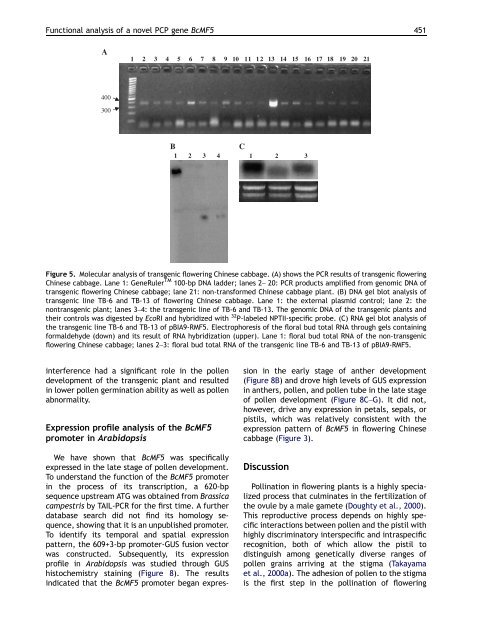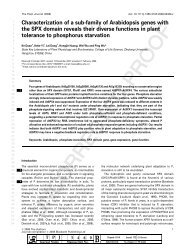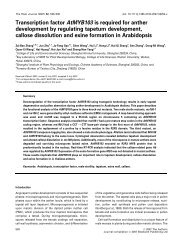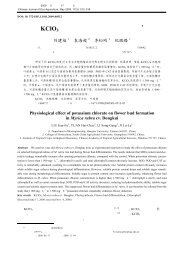Brassica campestris L. ssp. chinensis M
Brassica campestris L. ssp. chinensis M
Brassica campestris L. ssp. chinensis M
You also want an ePaper? Increase the reach of your titles
YUMPU automatically turns print PDFs into web optimized ePapers that Google loves.
interference had a significant role in the pollen<br />
development of the transgenic plant and resulted<br />
in lower pollen germination ability as well as pollen<br />
abnormality.<br />
Expression profile analysis of the BcMF5<br />
promoter in Arabidopsis<br />
We have shown that BcMF5 was specifically<br />
expressed in the late stage of pollen development.<br />
To understand the function of the BcMF5 promoter<br />
in the process of its transcription, a 620-bp<br />
sequence upstream ATG was obtained from <strong>Brassica</strong><br />
<strong>campestris</strong> by TAIL-PCR for the first time. A further<br />
database search did not find its homology sequence,<br />
showing that it is an unpublished promoter.<br />
To identify its temporal and spatial expression<br />
pattern, the 609+3-bp promoter-GUS fusion vector<br />
was constructed. Subsequently, its expression<br />
profile in Arabidopsis was studied through GUS<br />
histochemistry staining (Figure 8). The results<br />
indicated that the BcMF5 promoter began expres-<br />
ARTICLE IN PRESS<br />
Functional analysis of a novel PCP gene BcMF5 451<br />
400<br />
300<br />
1 2 3 4 5 6 7 8 9 10 11 12 13 14 15 16 17 18 19 20 21<br />
1 2 3 4 1 2 3<br />
Figure 5. Molecular analysis of transgenic flowering Chinese cabbage. (A) shows the PCR results of transgenic flowering<br />
Chinese cabbage. Lane 1: GeneRuler TM 100-bp DNA ladder; lanes 2– 20: PCR products amplified from genomic DNA of<br />
transgenic flowering Chinese cabbage; lane 21: non-transformed Chinese cabbage plant. (B) DNA gel blot analysis of<br />
transgenic line TB-6 and TB-13 of flowering Chinese cabbage. Lane 1: the external plasmid control; lane 2: the<br />
nontransgenic plant; lanes 3–4: the transgenic line of TB-6 and TB-13. The genomic DNA of the transgenic plants and<br />
their controls was digested by EcoRI and hybridized with 32 P-labeled NPTII-specific probe. (C) RNA gel blot analysis of<br />
the transgenic line TB-6 and TB-13 of pBIA9-RMF5. Electrophoresis of the floral bud total RNA through gels containing<br />
formaldehyde (down) and its result of RNA hybridization (upper). Lane 1: floral bud total RNA of the non-transgenic<br />
flowering Chinese cabbage; lanes 2–3: floral bud total RNA of the transgenic line TB-6 and TB-13 of pBIA9-RMF5.<br />
sion in the early stage of anther development<br />
(Figure 8B) and drove high levels of GUS expression<br />
in anthers, pollen, and pollen tube in the late stage<br />
of pollen development (Figure 8C–G). It did not,<br />
however, drive any expression in petals, sepals, or<br />
pistils, which was relatively consistent with the<br />
expression pattern of BcMF5 in flowering Chinese<br />
cabbage (Figure 3).<br />
Discussion<br />
Pollination in flowering plants is a highly specialized<br />
process that culminates in the fertilization of<br />
the ovule by a male gamete (Doughty et al., 2000).<br />
This reproductive process depends on highly specific<br />
interactions between pollen and the pistil with<br />
highly discriminatory interspecific and intraspecific<br />
recognition, both of which allow the pistil to<br />
distinguish among genetically diverse ranges of<br />
pollen grains arriving at the stigma (Takayama<br />
et al., 2000a). The adhesion of pollen to the stigma<br />
is the first step in the pollination of flowering








